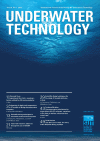
The impacts of anchoring and mooring in seagrass, Studland Bay, Dorset, UK
Studland Bay, Dorset, on the central south coast of England is shallow and well protected from the prevailing south-west winds, making it an ideal habitat for a dense seagrass bed of Zostera marina. The shelter and proximity to the port of Poole make it a popular anchorage. Bare
patches in the seagrass habitat associated with boat anchoring and mooring are described. Shear vane stress of the seabed was measured in situ by SCUBA divers. When comparing the undisturbed seagrass sediment with the bare, impacted areas, the latter sediments are less cohesive, contain
less organic material and have a lower silt fraction, infaunal organism number and taxa. A mechanism for the progression of an anchor scar is suggested, involving storm wave induced mobilisation and dispersion of the impacted sediments exposing the underlying rhizome mat, which is further
undermined by crabs. Results from this work and studies on other seagrass species suggest that the recovery is far from straightforward. It may take many years, leading to the decline of the Studland Bay seagrass habitat and associated species.
Keywords: EROSION; SCUBA DIVING; SEDIMENT INFAUNA; SHEAR VANE STRESS; ZOSTERA MARINA
Document Type: Research Article
Publication date: 01 November 2010
- Underwater Technology is the peer-reviewed international journal of the Society for Underwater Technology. The objectives of the journal are to inform and acquaint the Society's members and other readers with current views and new developments in the broad areas of underwater technology, ocean science and offshore engineering.
- Editorial Board
- Information for Authors
- Submit a Paper
- Subscribe to this Title
- Membership Information
- Terms & Conditions
- Ingenta Connect is not responsible for the content or availability of external websites
- Access Key
- Free content
- Partial Free content
- New content
- Open access content
- Partial Open access content
- Subscribed content
- Partial Subscribed content
- Free trial content